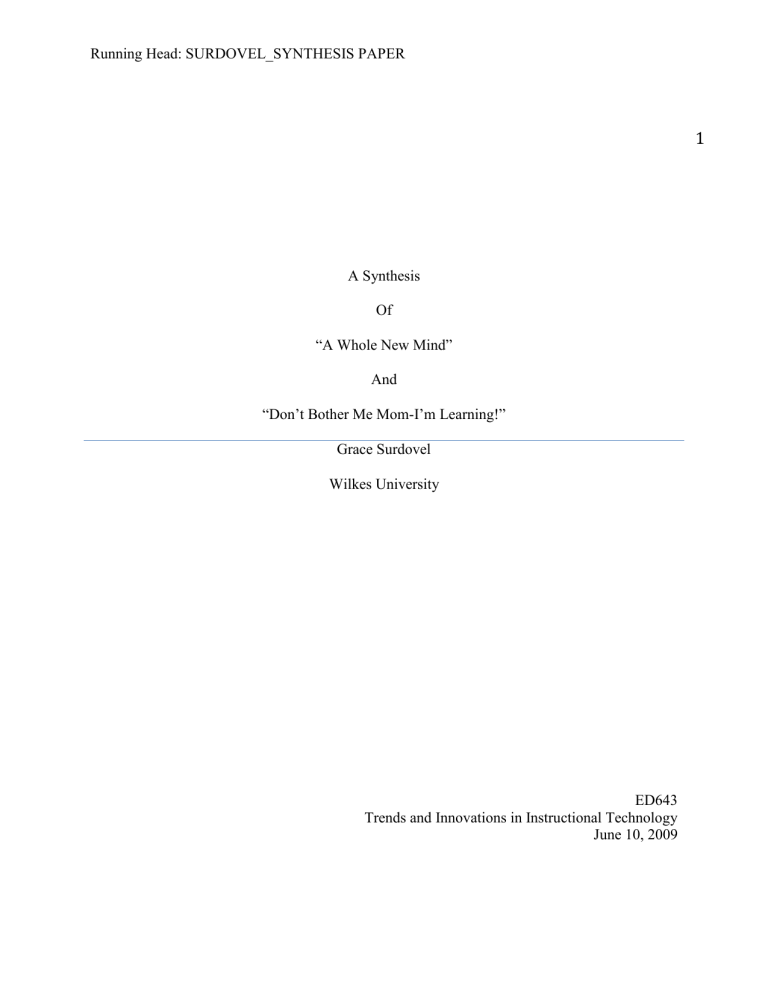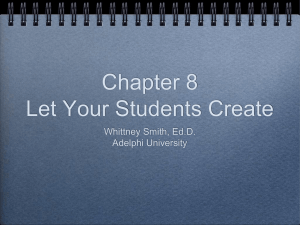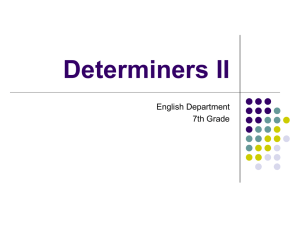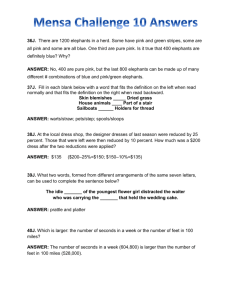Surdovel_ED643 Synthesis Paper

Running Head: SURDOVEL_SYNTHESIS PAPER
A Synthesis
Of
“A Whole New Mind”
And
“Don’t Bother Me Mom-I’m Learning!”
Grace Surdovel
Wilkes University
ED643
Trends and Innovations in Instructional Technology
June 10, 2009
1
SURDOVEL_SYNTHESIS PAPER
Abstract
This paper illustrates an examination and synthesis of two books: “A Whole New Mind” by
Daniel H. Pink and “Don’t Bother Me Mom, I’m Learning” by Marc Prensky. Both texts were examined, compared and contrasted in light of the learning theories and contemporary trends and innovations in instructional design and technology presented in the course texts. Common concepts, techniques and innovative technology practices were also discussed.
2
SURDOVEL_SYNTHESIS PAPER
A Synthesis
Of
“A Whole New Mind”
And
“Don’t Bother Me Mom-I’m Learning!”
The first text I selected for this synthesis was “A Whole New Mind” by Daniel H. Pink.
3
I chose this book because of my interest in the field of visual art and my previous teaching experience using the book, “Drawing on the Right Side of the Brain” by Betty Edwards. When
Pink explained his own experiences using this book as part of his whole brain enlightenment process, I was very excited and this possible “link” to the author increased my enthusiasm for reading this text.
The second text I selected was, “Don’t Bother Me Mom-I’m Learning” by Marc Prensky.
I selected this book because of its focus on the use of games as a means of facilitating student learning and my own curiosity around this growing movement in education.
The underlying rationale behind my selection of these two texts was my belief that all students need to be actively engaged in the process of knowledge creation. Even though I have this belief, I am also keenly aware of the fact that few students actually get to learn in this manner; at least the learning that happens in school. In choosing and reading these books, my hope was that I would be afforded a greater level of useful and timely information as well as some practical, hands-on resources I could use with my students. I was not disappointed.
In the book, “A Whole New Mind,” author Dan Pink begins by identifying the different periods of history (described as ages) through which American society and the American educational system have passed. He identifies these ages as: The Agricultural Age, The
Industrial Age, The Information Age and the Conceptual Age. Pink states that the Conceptual
SURDOVEL_SYNTHESIS PAPER
Age, as he calls the age he feels we as a global society have moved into, demands workers who can be both creators and empathizers. His rationale for the emergence of this “age” is his belief that there are three driving forces pushing this now globally-linked society into this new age. He identifies these forces as “Abundance, Asia and Automation”
(Pink, 2006, pp. 30-47). Pink then asks the reader to pose the following questions to themselves in regards to their current means of
4 employment:
1.
Can someone overseas do it cheaper?
2.
Can a computer do it faster?
3.
Am I offering something that satisfies the non-material, transcendent desires of an abundant age?
(Pink, 2006, p. 51)
Pink explains that a growing number of American workers have already lost their jobs to overseas workers or computer programs that cost their employers thousands less in salaries and benefits. He points to the growing number of American companies who have chosen to outsource their Information Technology work to countries such as India as one example of this shift. As a result of this shift, Pink believes that American workers must embrace this new age where the skill sets they will be required to possess will include those found under the heading of what he describes as “R-directed thinking.” Pink describes these skills as “inventiveness, empathy, joyfulness and meaning” (Pink, 2006, p. 26). In contrast, he points to the Information
Age as an example of a societal shift that was in his opinion too far in the direction of what he described as “L-Directed” or “rational, analytic, and logical thinking” (Pink, 2006, p. 26).
SURDOVEL_SYNTHESIS PAPER
In response to this movement into a new age, Dan Pink presents the need for what he describes as “The Six Senses” (Pink, 2006, p. 65). His belief is that these senses are the foundation of what will be required of a globally- linked American worker if they are to succeed
5 in the Conceptual Age. He Identifies these Six Senses as; “Design, Story, Symphony, Empathy,
Play and Meaning” (Pink, 2006, pp. 65-67). He describes Design as the process of creating solutions. Pink describes Stories as “important cognitive events, for they encapsulate, into one compact package, information, knowledge, context and emotion” (Pink, 2006, p. 103).
Symphony, according to Pink, is the process of inventing something new out of existing elements never before combined in this particular way. Empathy is described as the ability to stand in another’s shoes by means of imagination, listening and movement beyond self. Play is described as the important component of truly enjoying and being fully engaged in the work one does whether it is the work of the student or of the professional. Pink describes Meaning as the movement away from the desire for material abundance and towards a desire for a deeper sense of spiritual and emotional wholeness. Throughout his explanation of the six senses, Pink illustrates each particular sense with a portfolio of practical, hands-on tools the reader can use to enhance their use of that particular sense (Pink, 2006, pp. 65-244). With the identification of these senses and the practical techniques one can use to transition into the Conceptual Age, Dan
Pink guides the reader towards a point of readiness for the dawning of this new age.
In the book, “Don’t Bother Me Mom-I’m Learning,” author Marc Prensky presents the reader with what some would consider a radical idea; the use of video and computer games to teach students the skills they will need to succeed in a technology-rich, globally connected world. The forward of this book was written by well know author and professor James Paul Gee.
SURDOVEL_SYNTHESIS PAPER
A quote from this forward sets the tone for Prensky’s arguments. “How long will young people, especially teens, put up with the fact that their popular culture appears to incorporate better theories of learning than their school” (Gee, 2006, Forward)? In response to this question and, well aware of the fact that many of his readers may be skeptical regarding what he proposes,
Prensky presents the reader with a list of learning skills students will acquire while playing computer and video games. These skills involve such things as experimentation, manipulation of complex systems, collaboration and the use of strategies to overcome obstacles. With this list identified, Prensky then sets out to explain the vast differences between the preferred learning methodology of today’s students as opposed to those of their teachers and parents.
Prensky identifies today’s students by the title of “digital natives” (Prensky, 2006, p. 28).
The adults over 40 years of age, who are often responsible for teaching these students, he describes as “digital immigrants”
(Prensky, 2006, p. 28). He differentiates between the two by explaining how technologically linked the natives are as opposed to their immigrant teachers and parents. Prensky illustrates this point with examples from conversations and interviews with various students regarding their use of games and what skills they feel they are learning through the gaming process. His book also includes many helpful illustrations of how parents and teachers can connect with their gaming students in order to better understand their preference for game-based learning as well as to help bridge the divide between themselves and their native students or children (Prensky, 2006, pp. 28-51). In his concluding chapters, Prensky proposes an even more controversial prediction for the future. He states that he sees not only a strong shift toward student-directed, game-based learning (that will address the multi-disciplinary needs of students) but he also feels that a significant part of this shift will be what he terms the
6
SURDOVEL_SYNTHESIS PAPER
“disintermediation” (Prensky, 2006, p. 197-200) or removal of the traditional teacher from the learning equation. His predicts that these traditional teachers will instead be replaced with what he describes as “Learning Counselors” (Prensky, 2006, pp. 200-203) . He explains that, instead of being responsible for specific academic content, the learning counselors will assist and guide the student as they move through the process of self-directed learning. Prensky’s belief is that it is time to allow kids to “re-invent school” in a manner that will address their individual and group learning needs (Prensky, 2006, pp. 200-203).
When I examine these texts in light of the course content covered to date, I see some strong connections to both the learning theories covered as well as many of the presenters and authors addressed.
The first correlation I was able to identify was to both the constructivist and constructionist learning theories. In both books, the authors repeatedly point to the importance of learner engagement, the use of collaboration, the role of the instructor as one who supports the learner in goal setting and self-regulation as well as the need to encourage the learner to reflect on both what and how they are learning. At one point in the book, “Don’t Bother Me Mom-I’m
Learning,” author Marc Prensky makes a direct reference to the use of the Logo program by
Seymour Papert. For me, this was an obvious tip of the hat to a respected colleague. Reading this reference brought me back to the keynote address by Papert and how he enthusiastically and repeatedly stated that students are most successful at learning when they are actively engaged in the process of creating and constructing their own knowledge. I suspect Papert would be very pleased with the ideas proposed by Pink and Prensky.
7
SURDOVEL_SYNTHESIS PAPER
Another correlation I was able to identify was between the writings and ideas put forth in the Jonassen text and those proposed by Prensky. As explained previously, Prensky’s entire
8 premise in this book is rooted in the belief that students can self-direct their own learning through the use of technology and in fact, many of them already do! When this premise is examined through the lens of Jonassens’ statements regarding how technology fosters learning by means of such things as “simulation, games, modeling, community building, designing”
(Jonassen, 2008), it is obvious that these two authors are operating out of a similar set of beliefs regarding the role of technology in education. When one examines both authors in light of James
Paul Gee’s Learning Principles, the correlation becomes even more evident. According to Gee, learning happens when the student adheres to such principles as “active, critical learning; design; meta-level thinking; psychosocial moratorium and committed learning” (Gee, 2003).
A third correlation I would make would be to the video presentations by both Sir Ken
Robinson and Bill Gates. While neither presenter seems to advocate for the removal of the traditional teacher per se, both emphasize that our present school system is failing our students and that something radically new is needed in order to prepare our students for the demands of the globally-linked workforce.
In light of what Pink and Prensky propose in their books, it becomes increasingly clearer that a major overhaul of the American school system is imminent. As we learned in chapter 32 of “Trends and Issues in Instructional Design and Technology,” the new educational paradigm must address two crucial components: Theory and Research. With such a strong emphasis on standardized test scores, have we lost our emphasis on these two key components of genuine learning? I believe Pink and Prensky as well as the other authors and theorists we have discussed
SURDOVEL_SYNTHESIS PAPER would state that we have. As chapter co-author Brent Wilson explains, we are faced with enormous “future trends” (i.e. gaming and virtual worlds, communities of practice) and as educators, we can no longer deny their presence among us (Wilson, as cited by Reiser, 2007).
The question before us is: Will we respond in such a manner that will allow us to meet the needs of our students for an authentic, engaging, creative and self-directed learning environment in order to prepare them for lives in a technology-saturated, interconnected, global society? If we choose to follow the sage advice of these authors as well the theorists and practitioners presented in our course content, I believe we will possess the skills and resources needed to do so.
9
SURDOVEL_SYNTHESIS PAPER
References
Gee, J. P. (2003). What Video Games Have to Teach Us about Literacy and Learning. New
York, NY: Palgrave Macmillan. Retrieved from: http://mason.gmu.edu/~lsmithg/jamespaulgee2
Jonassen, D., Howland, J., Marra, R. M. & Crismond, D. (2008). Meaningful Learning With
Technology. Upper Saddle River, NJ: Pearson.
Pink, D. H. (2006). A Whole New Mind: Why Right Brainers Will Rule The Future. New York,
NY: Riverhead Books.
Prensky, M. (2006). “Don’t Bother Me Mom-I’m Learning!” St. Paul, MN: Paragon.
Reiser, R. A. & Dempsey, J. V. (2007). Trends And Issues In Instructional Design And
Technology. Upper Saddle River, NJ: Pearson.
10





